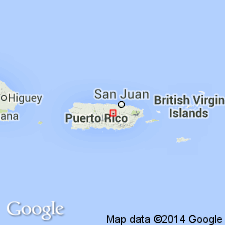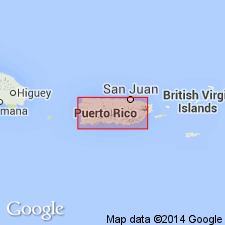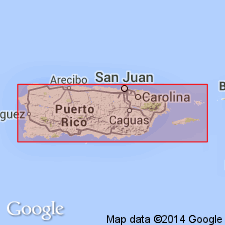
- Usage in publication:
-
- Mucarabones Sand*
- Modifications:
-
- Named
- Biostratigraphic dating
- Dominant lithology:
-
- Sand
- AAPG geologic province:
-
- Caribbean region
Summary:
The Mucarabones Sand, here named, consists of grayish-orange cross-bedded quartz sand interbedded with glauconitic calcareous sandstone and clay. Overlies San Sebastian Formation in eastern Corozal quadrangle, to the west it grades laterally into the Lares Limestone. Thickness ranges from 5 m in west where San Sebastian and Lares nearly meet, to 50 m. Age is middle Oligocene based on Foraminifera.
Source: GNU records (USGS DDS-6; Reston GNULEX).

- Usage in publication:
-
- Mucarabones Sand*
- Modifications:
-
- Revised
- AAPG geologic province:
-
- Caribbean region
Summary:
Mucarabones Sand assigned in the Rio Guatemala Group sharply and conformably over the San Sebastian Formation; grades laterally westward into and intertongues with the Lares Limestone and Cibao Formation. Age is middle Oligocene to early Miocene.
Source: GNU records (USGS DDS-6; Reston GNULEX).

- Usage in publication:
-
- Mucarabones Sand*
- Modifications:
-
- Overview
- AAPG geologic province:
-
- Caribbean region
Summary:
The Mucarabones Sand occurs on the north coast of Puerto Rico and consists of quartz sand, interbedded with glauconitic, calcareous sand and thin-bedded calcareous clay. Maximum thickness is 120 meters. The Mucarabones is of late Oligocene and early Miocene(?) age.
Source: GNU records (USGS DDS-6; Reston GNULEX).
For more information, please contact Nancy Stamm, Geologic Names Committee Secretary.
Asterisk (*) indicates published by U.S. Geological Survey authors.
"No current usage" (†) implies that a name has been abandoned or has fallen into disuse. Former usage and, if known, replacement name given in parentheses ( ).
Slash (/) indicates name conflicts with nomenclatural guidelines (CSN, 1933; ACSN, 1961, 1970; NACSN, 1983, 2005, 2021). May be explained within brackets ([ ]).

